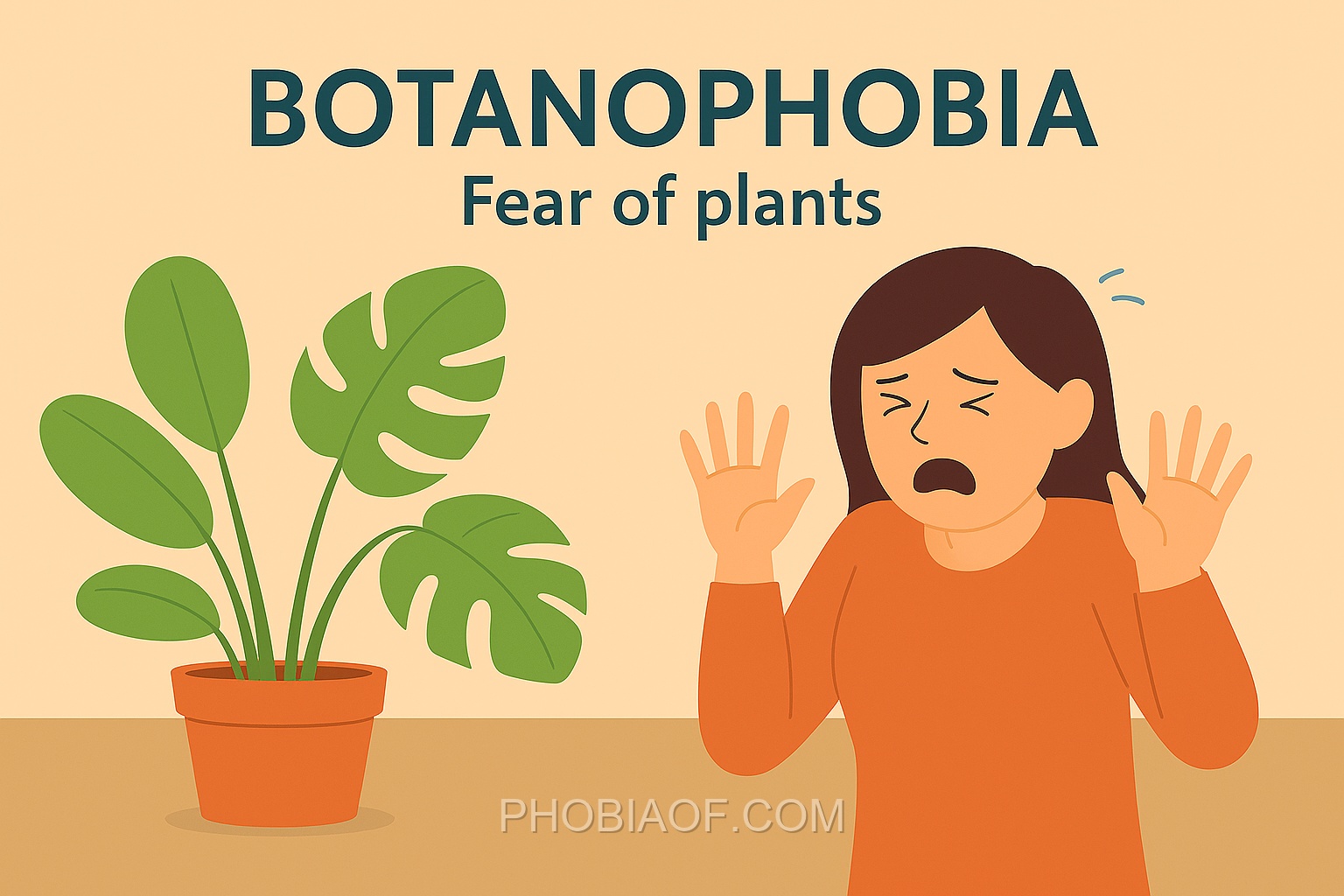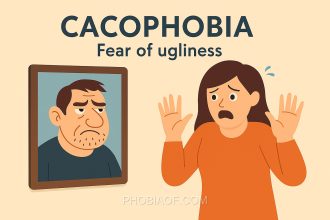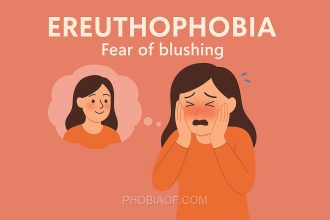Have you ever felt uneasy walking through a garden or experienced a sudden rush of anxiety at the sight of a houseplant? If so, you may be encountering something known as Botanophobia, the fear of plants.
Botanophobia comes from the Greek words “botane,” meaning plant, and “phobos,” meaning fear. It is an anxiety disorder where an individual experiences an irrational and persistent fear of plants. This fear can range from discomfort around trees and flowers to an aversion to being near any type of greenery.
People affected by Botanophobia may find themselves avoiding gardens, parks, or even homes with numerous houseplants. The fear might manifest as anxiety, panic attacks, or even physical symptoms like sweating and trembling when confronted with plants. Everyday situations, such as a walk in the park or caring for a houseplant, can become challenging.
While it may sound unusual to some, Botanophobia can significantly impact a person’s quality of life. It can limit their activities, social interactions, and even affect their mental well-being. Understanding and compassion are key, as those who suffer from it often need support in managing their fears and finding ways to coexist peacefully with the natural world.
Causes of Botanophobia
Botanophobia, the fear of plants, can stem from various sources. Understanding these causes can help in addressing and managing this fear effectively. Below are some common reasons why someone might develop botanophobia:
- Genetic Predisposition:
Some individuals may have a genetic tendency to develop phobias. This means that if someone in the family has anxiety disorders or specific phobias, others may be more prone to similar fears, including botanophobia.
- Traumatic Experiences:
Negative or traumatic encounters with plants in the past, such as being hurt by thorns, experiencing allergic reactions, or having a frightening incident in a dense forest, can trigger an ongoing fear of plants.
- Learned Behavior:
Children and even adults can develop botanophobia by observing the fearful reactions of others. If a parent or influential figure in one’s life displays a fear of plants, this behavior can be learned and internalized.
- Psychological Factors:
People with general anxiety disorders or a heightened fear response may be more susceptible to developing specific phobias, such as botanophobia. Stress and anxiety can amplify these fears.
- Environmental Influences:
The environment in which a person grows up can also play a role. Living in areas where certain plants are associated with danger, such as poisonous plants, can contribute to the development of botanophobia.
Interestingly, some research suggests that fears of natural elements like plants may have evolutionary roots. This theory proposes that an inherent caution around unfamiliar or potentially harmful plants could have offered survival advantages in the past.
Overall, botanophobia is a complex condition with multiple potential causes. Understanding these can aid in developing effective coping strategies or therapies to overcome the fear.
Symptoms of Botanophobia
Botanophobia, the intense fear of plants, can manifest in various ways, deeply affecting those who experience it. This phobia is not just a simple dislike but an overwhelming fear that can trigger significant emotional and physical responses. Those who suffer from botanophobia may experience the following symptoms:
Physical Symptoms:
- Panic attacks that may include shortness of breath, dizziness, and a feeling of losing control.
- Increased heart rate or palpitations when near plants or even thinking about them.
- Sweating and trembling in the presence of plants or plant imagery.
- Feeling nauseous or experiencing gastrointestinal distress.
Emotional and Behavioral Symptoms:
- An overwhelming sense of dread or terror when confronted with plants or plant-related environments.
- Avoidance of parks, gardens, or any settings where plants are prevalent.
- Distress or anxiety when discussing or seeing images of plants.
- Feelings of helplessness or being trapped when in proximity to plants.
These symptoms can severely interfere with daily life, making it challenging for individuals with botanophobia to engage in routine activities or enjoy outdoor environments.
Treatment for Fear of Plants (Botanophobia)
Overcoming botanophobia, the fear of plants, is possible with the right treatment and coping strategies. It’s important to understand that this phobia can be managed effectively over time, allowing you to lead a fulfilling life without unnecessary fear. Below are some proven treatment options and coping strategies to help you on your journey.
Therapies
Various therapies have been shown to be effective in treating botanophobia:
- Exposure Therapy: This involves gradually and systematically exposing yourself to the fear of plants in a controlled manner. The process helps desensitize your fear response, making the presence of plants less anxiety-inducing over time.
- Cognitive-Behavioral Therapy (CBT): CBT focuses on changing the negative thought patterns associated with your fear. By identifying and altering these thoughts, you can reduce the intensity of your phobia.
- Counseling: Speaking with a mental health professional can provide insights and strategies tailored to your specific situation, offering support and guidance as you work through your fear.
Self-Help Coping Techniques
In addition to therapy, there are several self-help techniques that can complement your treatment:
- Relaxation Exercises: Techniques such as deep breathing, progressive muscle relaxation, and visualization can help manage anxiety symptoms related to your phobia.
- Meditation: Regular meditation practice can enhance your ability to stay calm and focused, reducing the overall impact of fear on your daily life.
- Support Groups: Joining a support group provides a community of individuals who understand your struggles and can offer encouragement and advice.
Medication
In severe cases of botanophobia, medication such as anti-anxiety medications may be prescribed. However, it’s essential to focus on therapy and coping skills as the primary treatment approach.
Remember, seeking professional help is a vital step if botanophobia is interfering with your life. Mental health professionals can offer personalized treatment plans and support you on your path to overcoming this fear.
With patience, commitment, and the right support, you can successfully manage and reduce your fear of plants. Take the first step today by reaching out to a mental health professional and exploring the treatment options available to you.
Conclusion
Understanding the intricacies of botanophobia, from its causes to its symptoms, is a crucial step in empowering oneself to confront and manage this fear. By gaining insight into the origins and manifestations of this phobia, individuals can better prepare themselves to address it effectively. Knowledge is a powerful tool, and with it, you can begin the journey towards overcoming your fears.
It’s important to remember that many people successfully manage or even overcome their phobias with time, patience, and the right support. Whether it’s through self-help strategies, therapy, or medical guidance, there are numerous avenues available to help you navigate this challenge. If you find that your fear of plants is impacting your daily life, consider reaching out to a therapist or doctor for support. They can provide you with personalized strategies and support to help you cope.
Take heart in knowing that you are not alone and that support is available. Embrace the journey of self-discovery and healing, knowing that each step forward is a victory. With determination and the right resources, you can reclaim your life from botanophobia and cultivate a future filled with hope and resilience.






